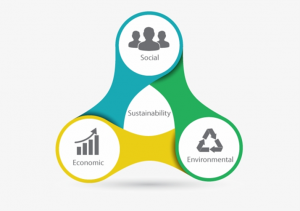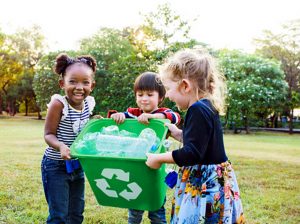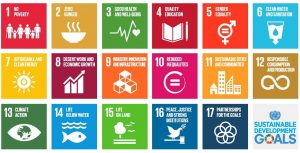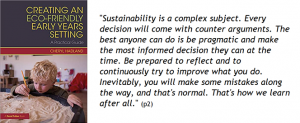On this blog post, we turn to sustainability expert June O’Sullivan MBE for insights and top tips you can use in your setting.
The issue of sustainability was in the forefront of everyone’s minds recently because of COP26, the event where countries revisited climate pledges made under the 2015 Paris Agreement. This event focused the world on how global leaders would acknowledge the complex issues of sustainability and how we address climate change.
The agreement – although not legally binding – will set the global agenda on climate change for the next decade and countries will meet next year to pledge further cuts to emissions of the carbon dioxide (CO2), a greenhouse gas which causes climate change. This is to try to keep temperature rises within 1.5C – which scientists say is required to prevent a “climate catastrophe”.
They also agreed an explicit plan to reduce use of coal which is responsible for 40% of annual CO2 emissions and pledged to financially support poorer countries to switch to cleaner energy. There was an explicit promise from China and the US, the world’s two largest CO2 emitters to work together to switch to clean energy.
Leaders from more than 100 countries, with about 85% of the world’s forests promised to stop deforestation by 2030, which is essential because trees absorb huge amounts of CO2. A scheme to cut methane emissions by 30% was also agreed by more than 100 countries. Methane is currently responsible for a third of human-generated warming. Progress will be checked at the next COP in Egypt which is in 2022.
But you may wonder as to what we in the Early Years can do to address these huge issues. Quite a lot as it turns out! Climate change is only one element of the three arms of sustainability and any decision made must be considered in the round as everything is interlinked. Here are three steps to get you started:
The FIRST thing we can support our staff to understand the concept of sustainability and introduced them to the three arms of sustainability:

In 1983 the United Nations created the Brundtland Commission because they were concerned by the continual calls for the world to think about whether economic development would be sustainable and if it would cause problems in the future. The Commission defined sustainability as designing a world that “…meets the needs of the present without compromising the ability of future generations to meet their own needs.”
This definition still stands and the subsequent design of the 17 sustainable goals with a roadmap to identify progress brought it much more to life. Early Years staff need to understand these two developments and then think about what we can do to address them in our own small way:
Read: Creating an Eco-Friendly Early Years Setting Hadland (2020)
Read: Understanding Sustainability in Early Childhood Education: Case Studies and Approaches from Across the UK Boyd, Hirst & Siraj-Blatchford (2018)
Read: Education for Sustainable Citizenship in Early Childhood Siraj-Blatchford & Brock (2016)
Check Out: ESD for 2030 Framework UNESCO Education for Sustainable Development
Check out: The Flourish Project

The SECOND thing to do is consider how you get the whole organisation involved. We know that change needs to come from the top and the bottom and the leaders need to ensure that it is filtered through policies and practice so its not just an add on project. If you are leading an early years setting, consider inviting staff to become Eco Champions and maybe they could attend a training programme to get them going. Think about involving the children, their parents and the wider community. Many people want to do something, but they are not sure where to start. Here at London Early Years Foundation (LEYF), we started by banning all single use plastic, using gloves only for emergencies and really soiled nappies and stopping all glitter. We have gone on to develop Green LEYF which is designed to help us create a culture of sustainability. The following book has lots of practical ideas to help you begin:
Read: 50 Fantastic Activities for Sustainability O’Sullivan & Corlett (2021)
Attend: The LEYF Level 4 Qualification in Sustainability in the Early Years.
Check Out: https://leyf.org.uk/green-leyf/
Check Out: https://gecco.org.uk/ Champions for change in the early years
The THIRD thing you can do is understand and agree one or two things you can do against the 17 Sustainable Development Goals (SDGs).

Here are some ideas:
Child poverty is a big issue. In the UK, 1 in 4 children live in families where according to the Social Metrics Commission (2020) work doesn’t always pay and 60% of people who work are still in poverty. Childcare needs to be affordable to enable parents to work but that is not the case. Our job is to pull together to make the argument clear to the wider public so they understand WHY Early Years matters and lobby the Government to rethink the under-investment.
Do you have a food bank? Do you support food banks? Find a food bank here…
Let’s share the importance of the children being outside with parents. Develop a real relationship with nature and get gardening.
Build your understanding of sustainability. Think about your resources. See this blog for a list of great books to introduce children to sustainability issues.
DG 5: Gender Equality
According to the EPI report (2020), the percentage of men in childcare is currently 7.4%. Can you help the campaign to increase the number of men in childcare and move it to 10%?
Teach children about water conservation in the nursery by learning not to waste it. Consider recycling rainwater in the garden, taps that don’t drip and loos that use less water to flush (grey water) or better still re-using rainwater as an irrigation system, planting drought loving plants and avoiding plastic bottled water.
Review your electricity consumption. Check the setting for old inefficient lighting. For example, an old style fluorescent light fitting would burn say, 120 watts, while an LED replacement could burn anything up to 60% less and can commonly achieve 45% less energy use.
Examine ways of providing staff with better benefits such as a good pension, proper training and development opportunities no matter what type of employment contract they have.
Create an audit to measure your efforts to reduce our carbon footprint. Think about new designs when refurbishing such as using trough sinks rather than individual ones as they waste a lot less water.
Inclusion is often narrowly perceived to be about race, gender and disabilities but it is much more than this and the Early Years sector must be fully alert to what this means in order to deliver inclusion. For example, a report by Simpson (2015) found that some ECEC staff allowed their personal view of poverty to impact on their responses to children including whether to seek additional support for the child as they believed the support would not be valued or continued at home.
How can we help make our neighbourhood greener and cleaner? Join a campaign to plant more trees. Use the local green space more. People appreciate these spaces when they see children enjoying them.
Our sustainability mantra at LEYF is wrapped around these 8 Rs:
| 1 | Reduce | Decrease consumption of food wastage, materials and resources |
| 2 | Reuse | Use materials many times and for different purposes |
| 3 | Repair | Fix things rather than discarding them or repurposing them. Understand the circular economy. |
| 4 | Recycle | Be aware of other ways of discarding rubbish. Teach children how to do this and the difference they can make to the planet. |
| 5 | Rot | Let things go back to the earth to enrich the next crop of plants while also providing a habitat for many insects. |
| 6 | Respect | Nurturing understanding of and respect of nature and natural processes. |
| 7 | Reflect | Embed the habit of being thoughtful, asking questions and wondering about experiences |
| 8 | Responsibility | Being socially and economically sustainable and making decisions that are sustainability responsible. |
Turn the heating a little lower. Walk where you can and maybe consider a bicycle scheme.
A first step would be to ban single use plastic, remove glitter, stop using clingfilm and replace wet wipes. All this would reduce plastic usage spreading to the oceans.
One very simple idea is to create a “Wildlife Photographer of the Year’ competition to encourage children and staff to take photos of wildlife they find in their gardens or on trips and outings – whether a small bug, a speedy squirrel or a noisy parrot!
Some children are growing up in places where there is no peace and Early Years settings are often the only safe space in their community. Look at your Inclusion policy and understand how you teach children to be respectful of each other within their communities. Take them out and about and visit local organisations and get involved in community activities.
This is our call to action. Sustainability is holistic. It is about the health and education of our children and relates to every part of their lives. We cannot continue to treat our planet with such disregard and force our children to inherit the predicted catastrophic 2050. Those of us leading in ECEC have a duty to future proof as much as possible and should learn how to tread lightly on the planet.
Remember that as Cheryl Hadland says:

So, take the first three steps and become a champion for sustainability. Sustainability is holistic. It is central to the child’s whole experience for life and needs to be part of a broad and inclusive quality education Think about the children and the world we are creating for them. They are the future citizens so let’s teach them to be kind and tread lightly on the planet. Join together and do our bit.